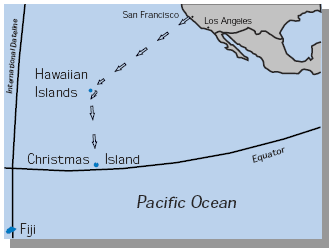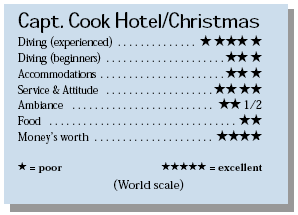Diving on ChristmasContents of this Issue: Southern Cross Club, Little Cayman The Answer to Inflatable Sharks Live by the Internet Die by the Internet Editorial Office: Ben Davison Publisher and Editor Undercurrent 3020 Bridgeway, Suite 102 Sausalito, CA 94965 South Pacific Diving Only Eight Hours From the States from the August, 1999 issue of Undercurrent
Dear Fellow Diver: My dive at Lionfish Wall started as a real drag: once all ten divers had backrolled into the water, our boat towed us through the half-knot current for what seemed like forever. I finally got to drop the line and start descending. But I wondered: geez, couldnít they have dropped us closer? Then, when I reached 80' and caught a glimpse of the fish life along the 30' high wall, my thoughts fled like schoolkids when the bell rings. The first thing to catch my eye was a flowing blue curtain, a huge, dense school
of blue-lined snappers. Peach and Bartlettís anthias and big scale and bronze
soldierfish swam nearby. Beside them were lemon peel and flame angels and small
schools of eye-striped surgeonfish in the undercuts. This is the kind of worldclass
diving I was expecting. Weíre deep. Christmas Islandís location, smack-dab in the middle of the Pacific, might conjure up images of pristine tropical paradise, but what I found on this barren atoll were huge dumps of rusting machinery and small mountains of 55-gallon drums. Though there are miles of gorgeous beaches, thereís little indigenous culture. The island has long been a fishermanís Mecca, but itís only begun to attract divers in significant numbers. Thatís surprising, because for a ďremoteĒ location, Christmas is an easy trip; by air, itís only three hours from Honolulu. Iíd heard enough about Christmasí serious coral bleaching during the 1997-98 El NiŮo that I was apprehensive about what Iíd find during my May trip. Fortunately, the hard corals seemed to have recovered with only a few spots of bleaching. And the fish life? Well, nearly every species that has made it from Micronesia to Hawaii is also found in the Line Islands (the Pacific island chain of which Christmas is a part). Surprisingly, I also found many species listed as having a range from the Red Sea to New Guinea. Although much of the diving lacks drama, this is about as close as you can get to unspoiled, virgin territory. Itís comparable to the central and southern Red Sea and certainly a big notch above Hawaiian diving. No walls plunge to infinity, but Christmas has great fish species diversity. Kim Anderson, the islandís only dive operator, has been on Christmas since 1992. His youthful enthusiasm, boyish smile, and friendly, outgoing nature belie his age. He met us the first morning and wasted no time gathering our group and starting his orientation. Then we loaded our gear into the two six-passenger trucks Kim left for us to drive between our hotel and Dive Kiribatiís shop on the islandís leeward side, 15 miles and a full 30 minutes away. My dive group had been assigned for the week to the Spinner with its operator and divemasters, usually Randy and Yoshi, both of them new to the area. Randy, with scruffy beard and graying hair, was friendly and experienced, but he lacked practice at finding the sites. Sometimes wasnít exactly where he thought he was. Yoshi was a knowledgeable Japanese marine biologist, though I had trouble understanding her accented English. While Kim clearly knows the sites, I only dove with him a couple times, though he answered my questions later. Dive Kiribati takes reasonable precautions but doesnít spoil the experience by hovering over people. Though dives were usually 55-70 minutes, time limits were seldom imposed, and they never provided a dive profile. Most sites were 30-65', though some were 100' or deeper. My group of nine U.S. divers had been pre-booked for three dives a day (17 over the week). Although Iím sure we could have controlled where we went, we had no idea where that should be, so we went with the flow. Dive Kiribati uses two unique
35' outrigger dive boats -- 4'
wide with a 15' pontoon-like outrigger.
A wide platform between
the boat and outrigger provided
room for half a dozen people to
stretch out (although the platform
became slippery when wet). Another
six divers and the crew could sit
on the ten-inch wide gunwales on
the main hull, shaded by a tarp.
Each boat had a sturdy ladder, a
cooler with icepacks, drinking
water, and a container of fresh
water large enough to soak three
cameras. On most dives the boats
held ten, but they were roomy
enough that we never had difficulty
finding somewhere shady to
sit or lie down. And lie down we
did, since we were on the boats
from 8:30 a.m. till 4:30 p.m.,
including 60-90 minute surface
intervals. My lodgings at the Captain Cook Hotel were comfortable but hardly a trip highlight. The place is funky but quaint, a single-story "Motel Six" accented with rock work. The hotelís two partially airconditioned wings hold about 50 guests. During my stay they were nearly 2/3 full of divers and fishermen. I stayed in the duplex bungalows nearby. They were South Pacific thatch-roofed but still echoed the hotelís prefablike structure. Mine took a mere stab at ambiance, but I had a sweeping, unbroken view of the pounding surf. Though they werenít air conditioned, in late May the rooms were comfortable with the constant sea breeze and a large rotating floor fan to keep the air moving at night. Each unit included a large bedroom with either a double bed or two twins, small bedside tables, a generous closet with built-in drawers, and a refrigerator -- nothing fancy, but clean and decent. The full bath had a separate double-size shower enclosure and a toilet room. Nonetheless, I prefer wonderful diving to a wonderful room. And Dive Kiribati introduced me to three sites that I consider world-class. While the bulk of our dives werenít stellar (they were topographically challenged), Christmas always delivered a vast assortment of marine life. The 30-mile Bay of Wrecks is an exception to the poor-topography rule. Named for the plethora of square riggers that ran aground there in the 17th and 18th centuries, the Bayís waters have long since reclaimed the hulls. The site was about an hourís drive across the island. Entries on the slippery, rocky beach were challenging, but the wall was one of Christmasí best. It started at 15' and dropped rapidly to beyond 200', although the best coral was from 20-60'. When I reached 25', a dozen calm but curious 4-6' gray reef sharks started swimming up to within 2' of me. Deeper, a huge school of immense blackfin barracuda meandered 20' off the wall. Solitary, seemingly oblivious 7' white tip reef sharks cruised by. The wall itself was full of hard coral and butterflyfish, threadfins, and lemon peel and flame angels. I spotted clown triggers doing a mating dance, standing on their heads and twirling around. A large school of big-eye trevally swirled in a classic vortex at 110'. We doubled back and exited on the beach where weíd entered. My legs were so tired that the waves knocked me down repeatedly, but the dive was worth it: a world-class dive Iíd compare to Blue Corner in Palau. Fish life and depths are similar, but here the sharks are close and youíre not surrounded by hundreds of other divers. At M Spot, a low hill of coral that begins about 30' and descends to a sand bottom at 65', a 12' manta passed over the mound several times, swimming slowly through the large schools of fish so cleaner wrasses could remove his skin parasites. At Eel Site I saw lots of octopi as well as giant, masked, and yellow-lined morays in several holes, some five to a hole. The site was like an apartment building where residents zipped in and out like dartfish whenever I approached, moving around the large moray who was always guarding the front door. On another morning we followed a pod of eight spinner dolphins for half an hour. With my mask in the water, I held onto ropes tied to the boatís pontoons as the boat pulled me along. Schools of large tuna, turtles, and mantas swam below. The fishermen were early risers, so breakfast was served early (5 a.m. till 8:30) to accommodate them. Choices included cold cereal and milk, coffee, orange juice, apple juice, scrambled eggs or omelets, bacon, toast, rice, and homefried potatoes (which were often undercooked). At times thereíd be pancakes, waffles, and grapefruit. Before dinner there was usually time to unwind over an Australian Victoria Bitter or something stronger, talk about the diving, and watch the sun paint the evening sky. Since the only edible products of Christmas Island are fish, lobster, and octopus, it suffers from the limited cuisine characteristic of most of Micronesia. Fruit and vegetables, like the tourists, are flown in from Hawaii. By the end of the week supplies had dwindled. Still, I found the food acceptable thanks to a creative kitchen. Entertainment was more exotic: a performance or dance with music or drums almost every night, sparks of native culture. One night we had a beachside luau replete with barbecued pig, and afterwards Gilbert Islanders in native costume passed out fragrant plumeria wreathes and performed traditional dances. To close the week, Kim brought his family and his divemasters to join us for a barbecue under the stars. Itís hard to draw hard and fast conclusions about Christmas. The diving will cause one person to rave, another to wonder. I was hoping to be stunned by a panoply of fish, and I did see an impressive array of critters Iíd never laid eyes on. However, some critters were missing: I saw no clownfish and few sweetlips, sponges, anemones, soft corals, or gorgonians. Even the diver whoís seen it all will find that the diverse fish species make heading to Christmas worthwhile. Itís not the spot for wall divers seeking drama or divers who want to photograph weird critters. But if youíre tired of overvisited sites and find yourself wondering what they looked like at the beginning of time, Christmas fills the bill just fine. óT. A.
|

I want to get all the stories! Tell me how I can become an Undercurrent Online Member and get online access to all the articles of Undercurrent as well as thousands of first hand reports on dive operations world-wide
| Home | Online Members Area | My Account |
Login
|
Join
|
| Travel Index |
Dive Resort & Liveaboard Reviews
|
Featured Reports
|
Recent
Issues
|
Back Issues
|
|
Dive Gear
Index
|
Health/Safety Index
|
Environment & Misc.
Index
|
Seasonal Planner
|
Blogs
|
Free Articles
|
Book Picks
|
News
|
|
Special Offers
|
RSS
|
FAQ
|
About Us
|
Contact Us
|
Links
|
3020 Bridgeway, Ste 102, Sausalito, Ca 94965
All rights reserved.

 We have some current, some verticality, a
little excitement. I got so absorbed in taking pictures I didnít notice I was alone
until I looked up and couldnít spot a diver within my 80' visibility. I was running
low on no-deco time, so I moved above the
wall and swam over the sandy slope, looking
for shallower reef. It was almost as interesting
as the wall, with big schools of
rainbow-runners circling me and several 2'
yellow-margin triggerfish carrying rocks in
their mouths, apparently building nests. I
surfaced after 50 minutes and the dive boat
picked me up 5-10 minutes later. The other
divers were excited because grey reef
sharks had been circling beneath them, one
of many unexpected bonuses of Christmas
Island diving.
We have some current, some verticality, a
little excitement. I got so absorbed in taking pictures I didnít notice I was alone
until I looked up and couldnít spot a diver within my 80' visibility. I was running
low on no-deco time, so I moved above the
wall and swam over the sandy slope, looking
for shallower reef. It was almost as interesting
as the wall, with big schools of
rainbow-runners circling me and several 2'
yellow-margin triggerfish carrying rocks in
their mouths, apparently building nests. I
surfaced after 50 minutes and the dive boat
picked me up 5-10 minutes later. The other
divers were excited because grey reef
sharks had been circling beneath them, one
of many unexpected bonuses of Christmas
Island diving.  With no formal break
for lunch, people snacked whenever
they wished. We had sandwiches each of us had prepared after breakfast
from the lunch buffet table: fresh bread,
jars of peanut butter, jam, salami, bologna,
reconstituted ham, sliced onions,
tomatoes, lettuce (at first), and cheese.
Fruit was usually just oranges and apples.
With no formal break
for lunch, people snacked whenever
they wished. We had sandwiches each of us had prepared after breakfast
from the lunch buffet table: fresh bread,
jars of peanut butter, jam, salami, bologna,
reconstituted ham, sliced onions,
tomatoes, lettuce (at first), and cheese.
Fruit was usually just oranges and apples. Diverís Compass: I booked through Dive Discovery, which
used Frontiers International Travel. Dive Discovery: phone
800-886-7321 or 415-256-8890; fax 415-258-9115; website
Diverís Compass: I booked through Dive Discovery, which
used Frontiers International Travel. Dive Discovery: phone
800-886-7321 or 415-256-8890; fax 415-258-9115; website
